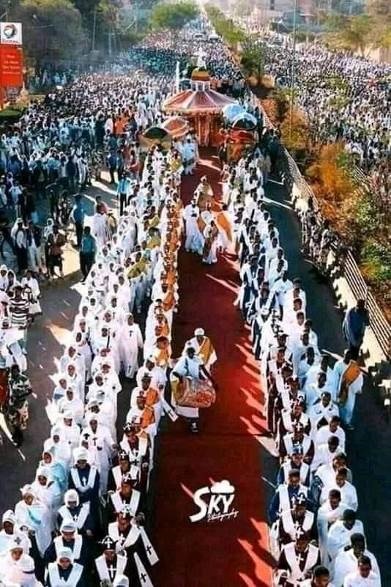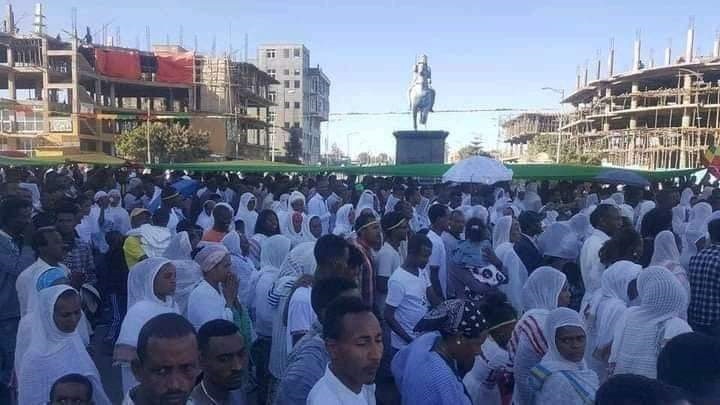By Faisal A. Roble
If Abdi Muhumed Omar was Ethiopianizing Somalis without Amharization, Mustafe Omar is Amharizing Somalis before he Ethiopianizes them.
In the wee-hours of the morning of January 19, 2022, a friend woke me up. He shared with me a live march by thousands of Amhara residents in the center of Jigjiga for the celebration of the epiphany or Timket day.

“Faisal, my friend,” he said, “take a look at how your city has been taken over!” Bewildered but still not sure what was happening, I started paying close attention to the pics and the chanting in the Video. The video was about a large crowd of non-Somali residents marching in the streets of the City; right then, I felt a fear I often detect in many Somalis; the fear of losing Jigjiga to Amhara residents.
The source of such a feeling is not by any means directed at the Amhara civilians who are marching in full force in Jigjiga. Rather, it is our collective perception that the current leadership in Jigjiga is not standing for the Somali interest. Mustafe Omar (Cagjer), who is president of the region, is repeatedly accused of using a language that prioritizes Amhara narrative over that of the Somalis. He has in many ways cut the footprint of the Somali narrative in favor of that of Amhara.
Why would he do that, you may ask? The most plausible answer is that Somali leaders in general, inclusive of Mustafe, only do things that make Addis Ababa happy. With or without federalism, Somali voices are yet to be heard. Because Somalis can’t either remove or keep their leaders in office, unprecedented levels of power abuse is common in the region. In other words, Somali citizens are not the source for legitimacy; Addis Ababa is. A known Somali poet is remembered for these poignant words: “ ma nin la soo doortay ayaad sii doorataan?” or; “ are you always content to re-nominate someone that has already been hand picked for you?”
Like his predecessor, Mustafe is oblivious to the collective complaints and legitimate fear of Somalis. Rather, he is abusive to them. For example, in one of his recent Facebook posts, he derisively addressed Somali complaints about the huge march of non-Somali residents in the streets of their city this way: “whether you like it or not, I don’t believe in ethnic federalism, and welcome to integration; live with it!” It is doubtful whether his behavior is softening the walls between Addis Ababa and Somalis or helping widen the already unmitigable historical and contemporary differences. In other words, Mustafe uses the Amhara narrative as a wedge issue to his benefit.

It is Orwellian that the march centered around the unmistakable statue of Sayyid Mohamed Abdulle Hassan, father of Somali nationalism. For the record, the statue was erected during the administration of Abdi Muhumed Omar (Illay) who is in jail for over three years without any charges. In passing, Abdi M. Omar’s effort all along has been to Ethiopianize Somalis without Amharizing, whereas Mustafe’s is to Amharize Somalia before he Ethiopianizes them. I will come back to this issue.
Somalis by any means don’t condone any action that harms innocent people practicing their religion in their city, as Islam believes in “lakum diinakum wali yadiin,” or “ to each according to his religion.” The collective complaint is rather about the upper hand given to outsiders and the continued marginalization of Somalis on their own soil.
Just for comparison: the last time Somalis organized a peaceful rally was in December, 2019. It was in support of Muslims whose Mosques were burned by ethno-nationalist mobs in Gonder. That march resulted in the death of a Junior High School Somali student. The marchers were attacked by allied forces of local police and an Amhara vigilante group. What is unremarkable is that the march had a legal permit to do so. This incident took me back to a similar incident in 1974 when Somali students in Jigjiga were attacked by a combined mob of Amhara citizens and the police force. Most of the Amhara citizens sided with the local police. Many Somalis wonder, therefore, why things stay the same for almost one-half of a century.
Hanging on to Our Narrative of Jigjiga
Jigjiga is home to great memories that refuse to die. As far back as 1900, the Sayyid Mohamed Abdulla Hassan ambushed Jigjiga to eject a small armed settler community sent by Ras Mekonen as an expeditionary contingent. The Sayyid’s mission was rebuffed by allied forces of neftegna and British soldiers mainly drawn from Somaliland Camel Corps. Towards the end 1900s, the combined army of Ras Mekonen and the British Camel Corps created a noose around the Sayyid and effectively defeated him. Sayyid Mohamed Abdulle Hassan died in December 1920 in Iimay, thus earning the status of the father of modern Somali nationalism.
In the 1940s, Jigjiga, the very town that Mustafa is accused of changing its flavor into a more Amharized texture, housed the Somali Youth Club (Somalis call it Gulub) that later on developed in to the endearing pan-Somali political movement of Somali Youth League (SYL). Emperor Haile Selassie made it his number one agenda to destroy the SYL but to no avail. To the contrary, it blossomed creating chapters in all Somali inhabited territories.
The first Chapter of SYL was inaugurated in Jigjiga around 1944. Chaired by the late Suldaan Hussein Giire, the women branch was headed by my own aunt, Khadija Au Libax, whose slogans and buraanbur became a rallying legend and a source for inspiration of the movement.
The late and former Prime Minister Abdirazak Haji Hussein, after escaping from the Italian security forces in Mogadishu, sought refuge in Jigjiga and lived there for about a year circa early 1950s. I met Abdirazak in 2012 in Minneapolis and he shared with me his respect and admiration for the people of Jigjiga.
In particular, he fondly cited the names of Ali Gudal and Abdi Iise. He said Ali Gudal was known for fundraising for the campaign to release Abdullahi Iise who ably served as the first secretary for SYL. As recalled, Abdillahi Iise was arrested in Mogadishu by Italy on the charge of treason. Abdirazak’s memory was so fresh he recalled, when I reminded him, the song Ali Gudal and his comrades used to sing during collection of donations from farmers, which went this way:
Ninkaa Cabdillahi Ciise
Cadaanka Dhexdiis
Ka Calaacali,
Allow Caawi
(my recollection).
He also remembered Abdi Iise, who was a young man active in recruitment of SYL members; Abdi Iise was one of the rare Somalis who spoke good English and often translated documents for Somali leaders.
According to M. Qadi, professor of Somali history who now lives in Minneapolis, one of the largest demonstrations against the British occupation of the Haud and Reserved Area took place in Jigjiga in 1948. Professor Qadhi, whose family hails from Shaxda or Buuhoodle, but lived in Jigjiga as a student in the 1940s told me that students of Jigjiga organized a massive demonstration to inform the Britons that they were not needed in the Haud and Reserved Area. The Britons used live ammunition and shot at the crowd. Since that time, Jigjiga never lost the luster for resistance and to ensure a strong Somali-centered narrative. By 1948, the region of Tuli Guuled was burning and a massive massacre was underway. Thus was Abdilahi Qarshi’s call for action:
Kacaay! Kacaay! Koraley la gubyey, Kacaay! Which in English translates as “Get up! Stand Up! Koraley is burning!” Koreley is a farming village about 30 miles to the north of Jigjiga and part of Tuli Guuleed District.
Mr. Michael Mariam and one Salool, both from Somaliland, spent energy and effort in the 1950s to protect and convince the Queen of England not to hand over Somali territories to Abyssinia. By 1957, they also took the case of ten Somali men accused of carrying SYL activities to the British courts but to no avail. According to Ambassador Hussein Ali Duale’s ““Raad Raaca Taariikhda Soomaalida,” a witness to the hanging, wrote that the ten men were accused of being SYL functionaries.
Dr. Hussein Bulhan memorialized his harrowing experience of watching the hanging of the ten men at the tender age of 10 in an article he published in the Horn of Africa Journal in 1980. In “The partition of Land and the Psyche in Somali Society,” Bulhan writes that the goal of the Abyssians was to instill fear in the Somalis. He also writes that people were forced to watch the hanging for one purpose: to show Somalis the level of cruelty of Abyssinia.
The New York Times equally wrote on this cruel act of Abyssinia. Despite a legal challenge put forth by Michael Marriam and Salol, where both were from Somaliland and carried British passports, the ten men, all from Tuli Guuleed, were hanged in the city’s public square on August 21, 1957.
For Somalis, Jigjiga is a sacred place and a melting point of many social groups. For the Ethiopian government, it has served as a point of entry for colonial conquest. It served and still does as the headquarters of the notorious Third Division of Ethiopian National Defense Forces. In present days, though, it is the gateway to government-sponsored Amharization.
Since EPRDF took power, two processes have been at play. Fake federalism with the intent to Ethiopianize Somalis, and the creation of a class of Somalis that is akin to what French sociologists called “evolve’”’ The current crop of evolve’ took shape in the Somali region since TPLF took power in 1991. By definition, evolve’ in the Somali context is a petty bourgeois loosely affiliated group that serves the government’s interest.
Whereas one group of evolve’ seeks Amharization, the other is bent on Ethiopianizing Somalis without Amharizing them. Mustafe Omar belongs to the first instance whereas Abdi Omar falls in the second category. Despite their differences, both leaders seek to minimize the footprint of Somali narrative. Both Mustafe Omar (Cagjer) and Abdi Omar (Illay), who are strangely childhood friends from the town of Dhagahbory, represent these two complimentary yet slightly different processes designed for Somalis. They both serve the same master – a ruthless and colonizing Abyssinia system. Therefore, their salient differences in rhetoric don’t warrant placing them into different camps..
Because more often than not, Somali leaders are chosen for them, they serve not Somalis but for the interest of Addis Ababa. Such was the reality on the ground under EPRDF/TPLF. And such is the same under PP. Therefore, Somalis see less or no difference between EPRDF, TPLF, and PP – all are cruel and cunningly colonial in nature to Somalis.
Whether the proposed national dialogue would maintain the same status and continue to marginalize Somali in their own land remains to be seen. However given the political culture of Ethiopia, Somalis better be more cautious and hope than hoping for much improvement.
Faisal A. Roble
Email: [email protected]
———–
Faisal Roble, a writer, political analyst and a former Editor-in-Chief of WardheerNews, is mainly interested in the Horn of Africa region. He is currently the Principal Planner for the City of Los Angeles in charge of Master Planning, Economic Development and Project Implementation Division.
We welcome the submission of all articles for possible publication on WardheerNews.com. WardheerNews will only consider articles sent exclusively. Please email your article today . Opinions expressed in this article are those of the author and do not necessarily reflect the views of WardheerNews.
WardheerNew’s tolerance platform is engaging with diversity of opinion, political ideology and self-expression. Tolerance is a necessary ingredient for creativity and civility.Tolerance fuels tenacity and audacity.
WardheerNews waxay tixgelin gaara siinaysaa maqaaladaha sida gaarka ah loogu soo diro ee aan lagu daabicin goobo kale. Maqaalkani wuxuu ka turjumayaa aragtida Qoraaga loomana fasiran karo tan WardheerNews.
Copyright © 2024 WardheerNews, All rights reserved


